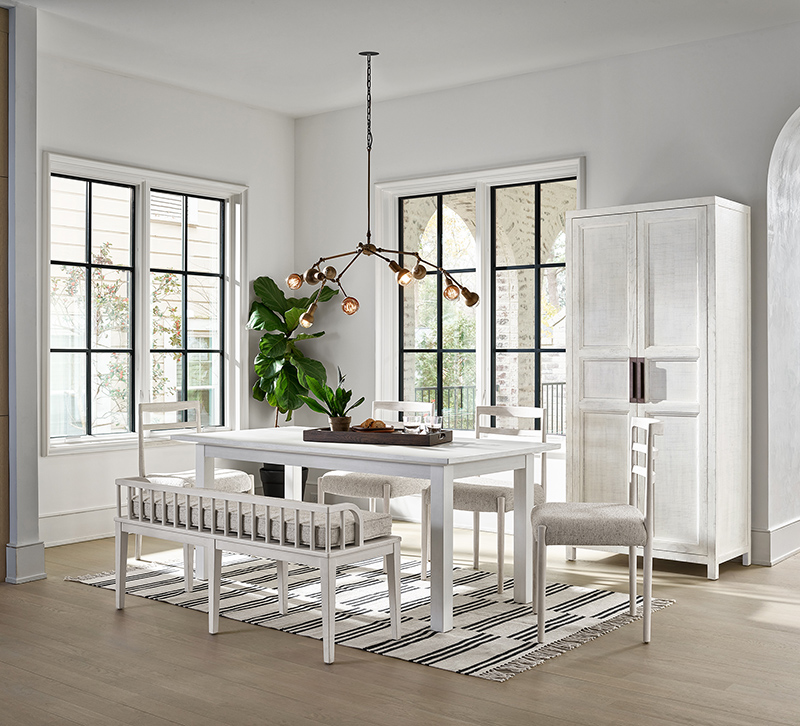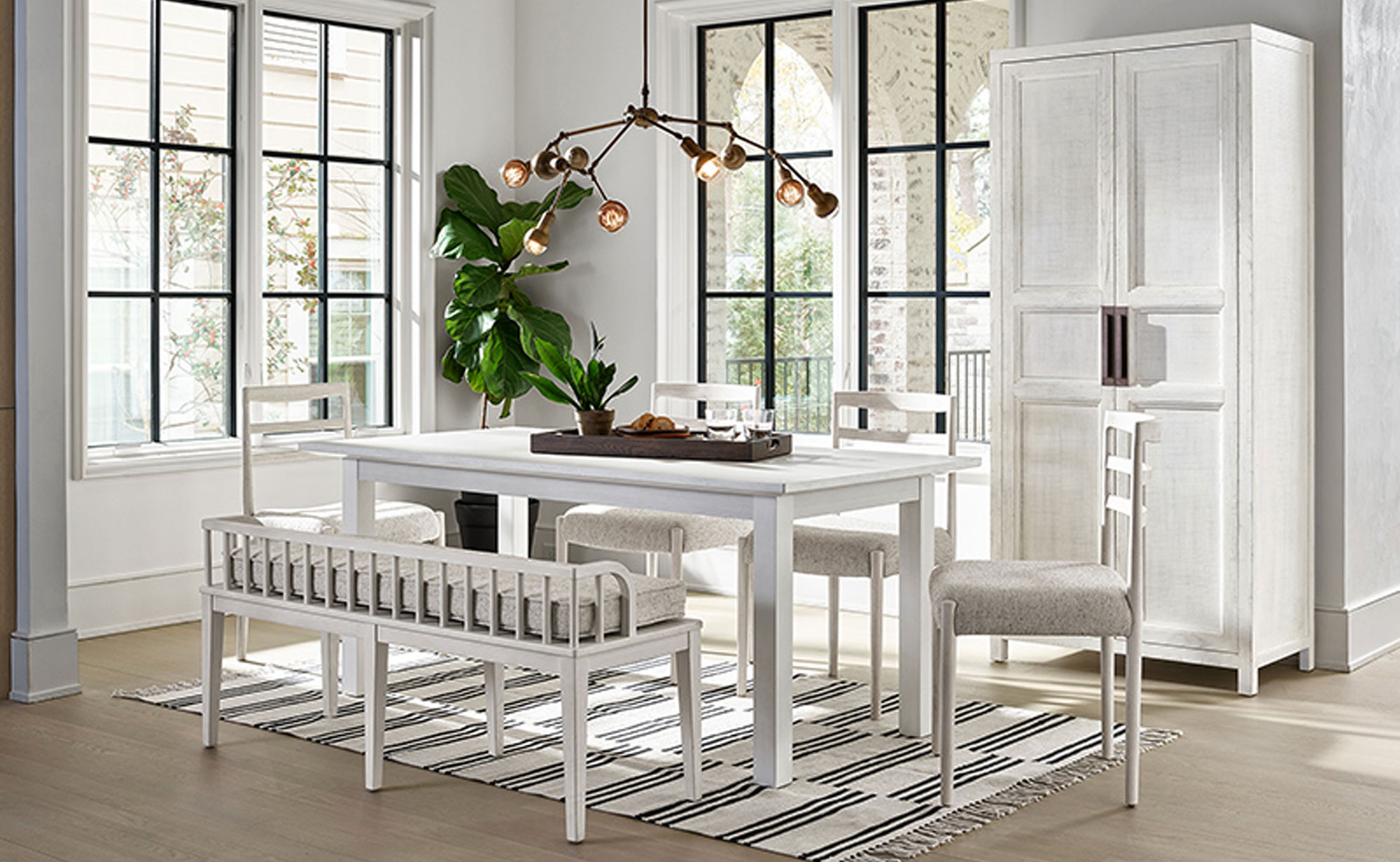The COVID-19 pandemic has shifted the concept of “home” to include work, school, daycare, and more. People are spending more time in spaces that were not designed with these new activities in mind, including dining rooms.
Interior designers, architects, and developers have reported an increase in homeowners who want to maximize their home’s existing square footage. Dining rooms, traditionally more formal spaces, are becoming more and more casual and functional.
Continue reading to learn Diane Falvey’s insights for maximizing efficiency when designing multi-purpose dining spaces, including helpful lighting design tips.
Editor’s note: The piece below was published online for Furniture Lighting & Decor. You can also read the piece here.
While the casualization of the dining room has been an ongoing transition, the COVID-19 pandemic has escalated the move towards more functional furnishings in a room that was once a pass-through space relegated to dinner parties and holidays.
Dining rooms are now far more lived-in spaces, being used to become a place for family dining, homework, temporary office, game night, and more, affecting how today’s consumer is outfitting the space.
“In the last year, spaces in the home are at a premium for different purposes. The idea that you have a room you eat in just a couple of times a year doesn’t exist anymore,” says Neil MacKenzie, Director of Marketing at Universal Furniture. “The dining room has become more approachable from a living standpoint.”

With a move toward a dining space that may now be used every day for varied purposes, consumers are looking more for durability, functionality, and flexibility. In Universal Furniture’s Modern Farmhouse collection, for example, some of the tables feature a laminate surface that offers a realistic wood look. “It’s an everyday living approach,” says MacKenzie. “It looks just like wood but you can do anything you want on it.”
The move to more durable surfaces makes sense to Interior Designer Lucy Penfield, Owner of Lucy Interior Design, in Minneapolis, MN. She is seeing a call for dining rooms that can be lived in as they are being used far more often with families at home. “The dining room has become the largest surface we have in our homes, the family anchor, so its finishes need to be more user-friendly, more comfortable, and a little more forgiving,” she notes. User-friendly, however, doesn’t mean anyone is taking high design away from what has now become a hub in the home. “We’re not compromising the beauty, but we’ve made it more livable,” Penfield continues. Some of the changes she has made in choosing dining room materials would be quartz surfaces instead of marble or reclaimed wood tabletops instead of a more fragile Walnut veneer, for example.

Flexible and more comfortable seating has become a standard in dining spaces, as in this design from Lucy Penfield.
Jamie Merida, Owner of Bountiful Home and Jamie Merida Interiors, in Easton, MD, says he is seeing some of his clients moving away from the open-space living concept. “I have two or three clients who have big period houses; they want to have multiple places to eat, including a formal dining room.” While they are looking for that formal space, he continues, it doesn’t mean they are outfitting the space with formal furnishings. For example, one client opted for a weathered elm, antique-looking trestle table with more formal chairs, he says, “sort of a high-low aesthetic.” These large weathered tables are something Merida is seeing sell through well in his retail store Bountiful Home too. “We can’t keep them in.” Other materials that customers are trending toward include marble-look tops that are actually ceramic and virtually indestructible, Merida adds.
Another must-have from a durability perspective in today’s dining spaces is seating performance. Comfort is important, as we may be spending more time in these chairs these days, lending to different chair styles. Equally as important are the fabrics that can dispel spills or are easily wiped up. “Offering performance fabrics on chairs and dining benches is something we’ve been paying attention to,” Universal’s MacKenzie notes. “That makes the pieces much more functional.”
Performance fabrics have come a long way in the past several years, too, and now have a wider variety of patterns, colors, and textures, along with stain resistance. “Regardless of the customer, performance fabric has become sort of a default,” says Merida. “The hand is good, the patterns are good. Through the high-end fabric manufacturers, performance fabrics are gorgeous. Performance goes a long way.”
Penfield sees the dining room as a way to mix and match seating design, keeping options available when extra seating is needed. Or, she says, an antique sideboard might be pulled into a room with a more transitional or contemporary style dining table and chairs. The design of the dining room is no longer about matched pieces, she says.
Penfield isn’t alone in the mixing of materials and styles in this space. As regionality, space configurations, aesthetic and personal preferences tend to play into what clients/customers will actually put into their dining spaces, suppliers, retailers, and designers come armed with choices that will appeal to many.
Fortunately, there is no shortage of design options to choose from. Suppliers offer a wide range of flexible dining room configurations as well, from larger tables (with or without leaves), round top dining tables, and myriad seating options. Dining table benches have come back into play too, Universal’s MacKenzie notes, as they allow for more flexible seating.
It’s no longer about the dining room suite, but rather a mix of pieces that can function in more than one way in a room that has seen increased activity, particularly over the last year.
As dining room spaces continue to be re-imagined, there are also the decorative elements that add the personality to the space. Lighting isn’t optional, and as the formal dining furniture has evolved, so have light fixtures above the table. That’s not to say a beautiful crystal chandelier may not still be appreciated, but consumers who are creating these multi-functional dining rooms are also focusing on the light their fixtures deliver for varied tasks as well as the style.
“We’ve seen our customers moving away from the ornate Elizabethan multi-crystal chandelier in the dining room in favor of more modern, simplified shapes,” says Robin Gordon, Vice President of Marketing at Elk Home.
Merida notes that an overhead fixture may not be enough with all the extra activity taking place in the dining room, suggesting recessed lighting or other task lighting that also helps when the dining room is a classroom or workspace. “Through the joy of dimmer switches, it can look beautiful all the time,” he adds.
Other decorative elements such as curtains, artwork or accessories also work to elevate design. According to Penfield, feathering in personality is key to a livable space. “What do we want to look at?” she suggests. Bold wallpaper, beautiful drapery, dressing up a sideboard with fun handles…these types of details can all bring life and interest to the room. In open floor plan situations, too, decorative elements can differentiate the dining space.
Merida agrees that there’s room for personality in dining spaces. It’s a space where you can possibly add a piece of contemporary art to an otherwise traditional setting, for example. With decorative centerpieces and accents, he adds, you want to be practical too. “You want something that’s not fragile and easy to move,” he says.
As we power through this pandemic, we can expect to see dining room furnishings evolve, but it’s likely this more informal approach will continue to drive consumer preferences.
In Penfield’s design business, creating spaces for her clients is all about telling the family’s story. “We’re here to bring their story to life through the finishes and selections in their homes,” she says. What does that mean for the future of dining spaces? It’s likely we’ll continue to see that mix of styles and configurations as we move forward.